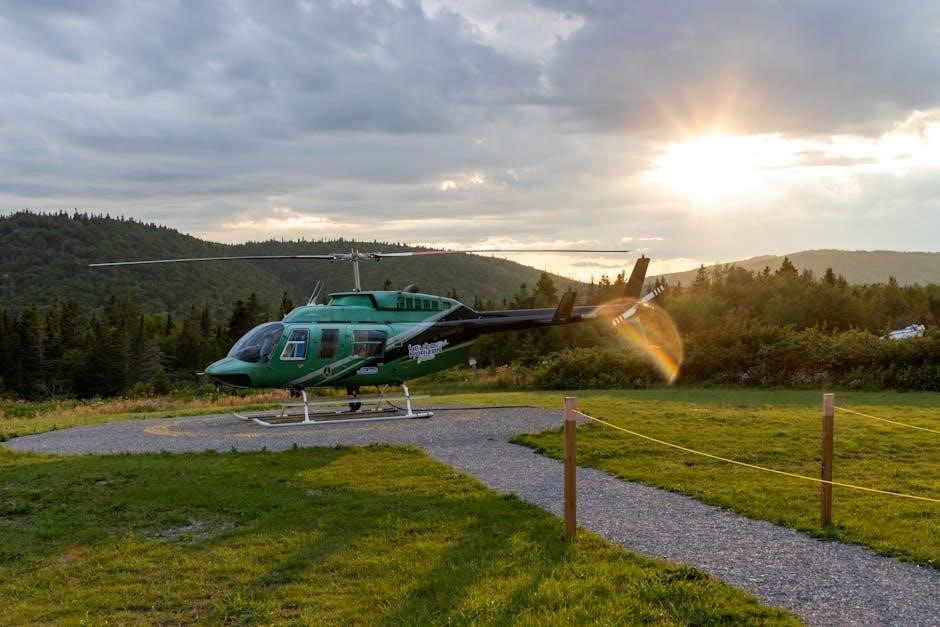The Rotorcraft Flight Manual is a comprehensive guide essential for safe and efficient flight operations, detailing performance, aerodynamics, and emergency procedures for pilots.
1.1 Purpose and Scope
The Rotorcraft Flight Manual serves as a standardized guide for safe and efficient rotorcraft operations, detailing essential procedures for pilots and operators. Its primary purpose is to provide clear, concise information on performance, aerodynamics, and emergency protocols. The scope encompasses design specifications, operational limits, and regulatory compliance, ensuring adherence to certification standards like CAT A and CAT B. It caters to both private and commercial pilots, offering a comprehensive reference for pre-flight, in-flight, and post-flight procedures. The manual also addresses maintenance practices and decision-making frameworks, making it an indispensable resource for rotorcraft enthusiasts and professionals alike, promoting flight safety and operational excellence.
1.2 Structure and Content
The Rotorcraft Flight Manual is organized into logical sections, ensuring easy access to critical information. It begins with introductory chapters, followed by detailed sections on aerodynamics, flight controls, performance, and emergency procedures; The manual includes checklists, diagrams, and operational guidelines tailored for both private and commercial pilots. Additional resources, such as navigation aids and communication protocols, are covered extensively. Appendices provide supplementary data, including weight and balance calculations, endurance formulas, and certification standards. The structure is designed to enhance understanding and practical application, making it a vital resource for pilots seeking to master rotorcraft operations safely and efficiently.
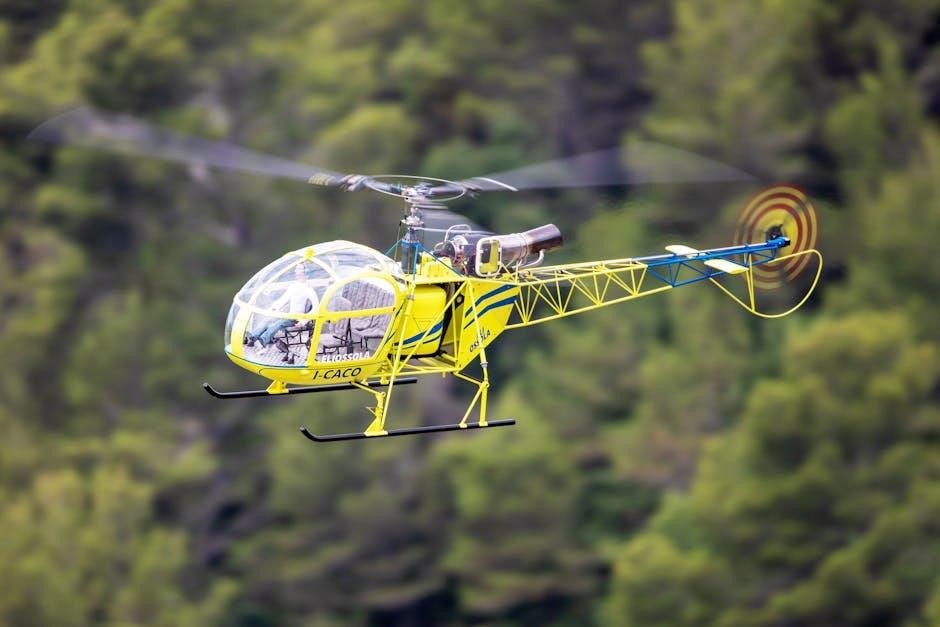
Aerodynamics of Rotorcraft
The section explains rotorcraft aerodynamics, focusing on lift, thrust, and airfoil dynamics. It details how rotor blades generate lift and interact with airflow to ensure efficient flight performance.
2.1 Basic Principles of Lift and Thrust
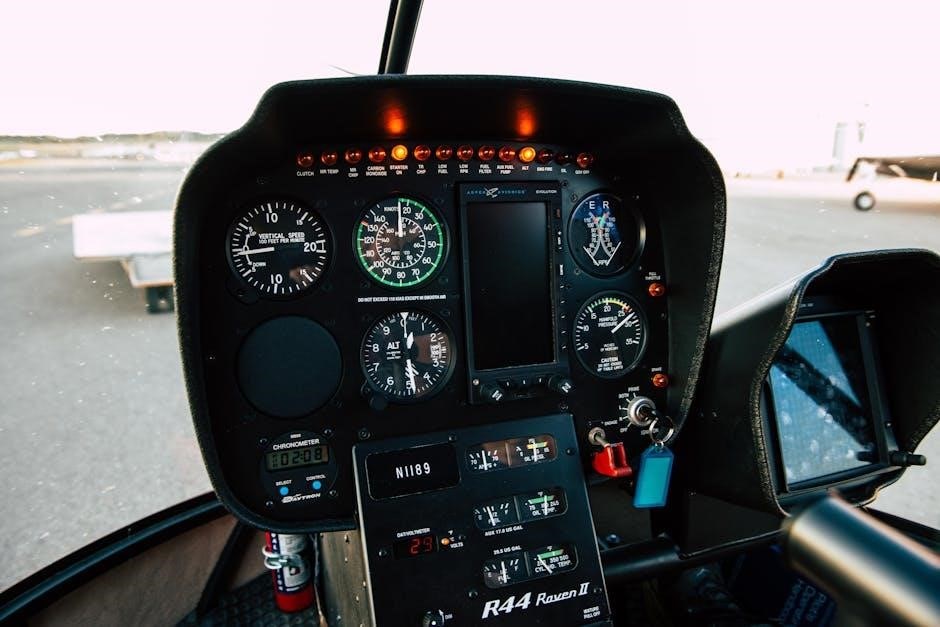
The aerodynamic principles of rotorcraft focus on lift and thrust generation. Lift is created by the rotor blades acting as airfoils, producing a pressure difference between the upper and lower surfaces. Thrust is developed when the rotor blades, angled to optimize airflow, push air downward, generating forward or upward motion. The shape and angle of attack of the blades are critical, as they influence both lift and thrust efficiency. Understanding these principles is essential for mastering rotorcraft performance and maneuverability, as detailed in the Rotorcraft Flying Handbook, which provides extensive insights into aerodynamic dynamics and their practical applications in flight operations.
2.2 Rotor Blade Dynamics
Rotor blade dynamics involve the complex motion and behavior of blades during flight. The blades experience forces such as centrifugal force, aerodynamic loads, and mechanical stresses. Flapping and lead-lag motions are natural responses to these forces, ensuring stability and efficiency. Blade angle adjustments, controlled by the pilot, regulate lift and thrust. Engine speed and rotor RPM are critical for maintaining optimal blade dynamics. Proper understanding of these principles, as outlined in the Rotorcraft Flying Handbook, is vital for safe and effective flight operations, ensuring the rotor system performs efficiently under various conditions and maneuvers.
2.3 Factors Affecting Rotor Efficiency
Rotor efficiency is influenced by several factors, including airfoil shape, angle of attack, and blade surface conditions. Environmental elements like air density, temperature, and humidity also play a role. The Bell 429 Flight Manual highlights that maintaining optimal rotor RPM and blade tracking is crucial. Additionally, wear and tear on blade surfaces can reduce efficiency. Proper maintenance and regular inspections, as detailed in the Rotorcraft Flying Handbook, are essential to ensure peak performance. Understanding these factors helps pilots optimize rotor effectiveness, enhancing overall aircraft performance during various flight conditions and maneuvers.
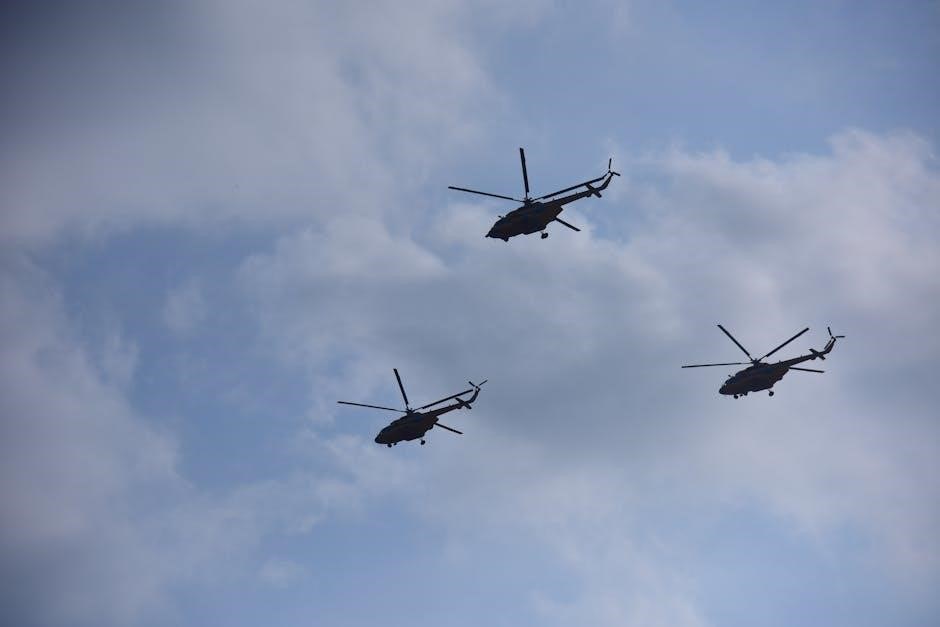
Flight Controls and Systems
The rotorcraft’s flight controls include cyclic, collective, and tail rotor systems, which work in conjunction with hydraulic and mechanical components to ensure precise aircraft maneuverability and stability.
3.1 Cyclic, Collective, and Tail Rotor Controls
The cyclic, collective, and tail rotor controls are the primary systems that enable a rotorcraft to achieve controlled flight. The cyclic control manages lateral movement and pitch, adjusting blade angle to alter direction. The collective control adjusts the angle of all rotor blades simultaneously, affecting lift and climb. The tail rotor counteracts torque and controls yaw. Together, these systems provide precise control over the aircraft’s altitude, direction, and orientation. Proper coordination of these controls is essential for safe and efficient flight operations, as outlined in the Rotorcraft Flying Handbook and the Bell 429 Rotorcraft Flight Manual.
3.2 Hydraulic and Mechanical Systems
Hydraulic and mechanical systems in rotorcraft are critical for maintaining control and stability during flight. Hydraulic systems power components such as servo actuators, which control the movement of the rotor blades, while mechanical systems manage the physical connections and gearing. These systems work in tandem to ensure smooth operation of the cyclic, collective, and tail rotor controls. Regular maintenance and monitoring of fluid levels, pressure, and component wear are essential to prevent failures. The Bell 429 Rotorcraft Flight Manual and the Rotorcraft Flying Handbook emphasize the importance of understanding these systems for safe and efficient flight operations, as outlined in their detailed guidelines and procedures.
3.3 Avionics and Navigation Systems
Avionics and navigation systems in rotorcraft are essential for precise flight operations and situational awareness. Modern rotorcraft utilize advanced systems like GPS, VOR, HSI, ADF, and RMI for navigation, ensuring accurate positioning and course tracking. These systems integrate with avionics suites to provide real-time data on altitude, heading, and speed. Communication systems, including radios and intercoms, enable clear interaction between the pilot and air traffic control. The Rotorcraft Flying Handbook highlights the importance of understanding these systems for safe navigation, while manuals like the Bell 429 Rotorcraft Flight Manual detail their operation and integration with other flight systems for optimal performance and safety.
Performance and Limitations
Performance factors include hover capabilities, climb rates, and maximum speeds, while limitations involve weight restrictions, altitude ceilings, and environmental conditions affecting operational safety and efficiency.
4.1 Performance Factors and Calculations
Performance factors in rotorcraft operations include lift, thrust, weight, and altitude, influencing hover, climb, and forward flight capabilities. Calculations involve determining power requirements, rotor efficiency, and environmental impacts like temperature and humidity. Pilots use these metrics to assess operational limits, ensuring safe and efficient flight. The Rotorcraft Flight Manual provides detailed charts and graphs to visualize performance data, aiding in pre-flight planning and real-time adjustments. Understanding these factors is crucial for optimizing rotorcraft capabilities while adhering to safety protocols and operational constraints. Accurate calculations ensure pilots can predict and achieve desired performance under various conditions, minimizing risks and enhancing overall mission success.
4.2 Hover and Climb Performance
Hover and climb performance are critical for rotorcraft operations, requiring precise power management and control. Hovering demands high rotor thrust to counteract weight, influenced by factors like air density and rotor efficiency. Climb performance involves transitioning from hover to forward motion, balancing power and angle of attack. The Rotorcraft Flight Manual provides specific data on hover ceilings and climb rates under various conditions. Pilots must consider environmental factors such as temperature, humidity, and wind to achieve optimal performance. Proper techniques ensure smooth transitions and maintain aircraft stability, crucial for safety in both normal and emergency situations. Efficient hover and climb maneuvers enhance overall mission effectiveness and safety margins.
4.3 Takeoff and Landing Performance
Takeoff and landing performance in rotorcraft involves precise control of power, angle of attack, and airspeed. These phases are critical due to the transition from ground to flight and vice versa. The Rotorcraft Flight Manual provides detailed procedures and performance data, ensuring safe operations. Factors such as weight, altitude, temperature, and wind affect takeoff and landing distances. Pilots must adhere to specified techniques to maintain control and avoid hazards. Proper execution of these maneuvers is essential for minimizing risks and ensuring passenger and aircraft safety. Effective planning and adherence to manual guidelines are crucial for successful takeoffs and landings under various conditions.
4.4 Endurance and Range Calculations
Endurance and range calculations are critical for rotorcraft mission planning, ensuring fuel efficiency and safe operations. The Rotorcraft Flight Manual provides formulas and charts to determine maximum flight duration and distance. Factors such as fuel capacity, consumption rates, wind conditions, and payload weight significantly impact these calculations. Pilots must accurately assess environmental conditions and aircraft performance to optimize flight plans. Proper endurance and range planning prevents fuel exhaustion and enhances operational safety. These calculations are essential for both short and long-range missions, ensuring rotorcraft meet intended flight objectives effectively.
4.5 Weight and Balance Considerations
Weight and balance are critical for rotorcraft stability and safety. Proper distribution ensures optimal performance and prevents potential hazards. Exceeding weight limits can lead to reduced control and increased risk of accidents. The flight manual provides specific guidelines for calculating the center of gravity and maximum allowable loads. Pilots must carefully account for fuel quantity, passenger numbers, and cargo distribution. Regular pre-flight checks ensure compliance with established safety standards. Adhering to these guidelines is essential for maintaining safe and efficient flight operations.
Flight Maneuvers and Techniques
This section covers basic and advanced flight maneuvers, including takeoff, landing, and autorotation, providing pilots with essential skills for safe and efficient rotorcraft operation.

5.1 Basic Flight Maneuvers
Basic flight maneuvers form the foundation of rotorcraft piloting, including hover, takeoff, climb, descent, and landing. Mastery of these skills ensures safe and controlled flight operations. Pilots learn to coordinate cyclic, collective, and tail rotor controls to achieve smooth transitions and maintain stability. Hovering, a critical maneuver, requires precise control inputs to keep the aircraft stationary in various wind conditions. Takeoff and landing techniques emphasize collective pitch management and airspeed control. These maneuvers are practiced extensively to build muscle memory and situational awareness, essential for handling diverse flight scenarios effectively and safely. Proficiency in basic maneuvers is vital for progressing to advanced techniques.
5.2 Advanced Flight Techniques
Advanced flight techniques in rotorcraft involve mastering complex maneuvers beyond basic operations. These include precision autorotations, instrument flying, and navigating challenging weather conditions. Pilots learn to handle emergency scenarios, such as system failures, while maintaining aircraft control; Autorotation, a critical skill, involves descending without engine power by using rotorblade autorotation. Advanced techniques also cover low-visibility operations and night flying, requiring heightened situational awareness. Integration of modern avionics, like GPS and autopilot systems, enhances precision and safety. These techniques demand a deep understanding of aerodynamics, weather, and aircraft limitations, enabling pilots to operate effectively in diverse and demanding environments while ensuring passenger and mission safety.
5.3 Autorotation and Emergency Procedures
Autorotation is a critical emergency procedure where the rotorcraft descends using autorotation to maintain control without engine power. Pilots must master this technique to safely land in engine failure scenarios. Emergency procedures include identifying safe landing zones, configuring the aircraft for autorotation, and executing controlled descents. Proper airspeed management, rotor RPM control, and timely flare execution are essential. These procedures demand precise training and practice to ensure successful outcomes.Autorotation and emergency landing techniques are thoroughly detailed in the Rotorcraft Flight Manual, emphasizing safety and quick decision-making to handle unexpected situations effectively.
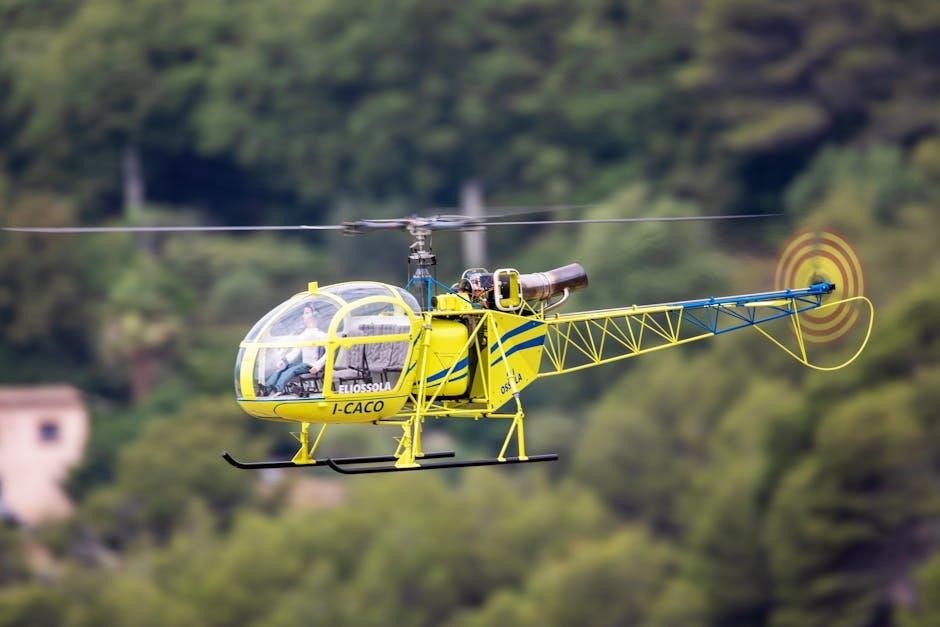
Emergency Procedures
Emergency procedures in rotorcraft operations ensure safe outcomes during critical situations, including system failures, engine issues, and unexpected events, requiring prompt, well-trained responses by the pilot.
6.1 System Failures and Recovery
System failures in rotorcraft demand immediate attention to ensure safety. Identification of failure types, such as hydraulic or electrical malfunctions, is critical. Standardized recovery protocols, outlined in manuals like the Bell 429 Rotorcraft Flight Manual, guide pilots through structured procedures. These include isolating failed systems, redistributing workload, and preparing for emergency landings if necessary. Training emphasizes quick decision-making and adherence to checklists to minimize risks. Effective communication with air traffic control and crew members is also vital. Proper recovery techniques ensure the aircraft remains controllable, prioritizing passenger and crew safety. Regular drills and simulations help pilots master these procedures, enhancing overall operational safety.
6.2 Engine Failure and Autorotation
Engine failure in rotorcraft necessitates immediate action to enter autorotation, a procedure where the rotor blades generate lift without engine power. The pilot must reduce collective pitch, maintain rotor RPM within safe limits, and establish a controlled descent. Autorotation requires precise airspeed management to ensure a stable glide path. The Rotorcraft Flying Handbook emphasizes that timely identification of a safe landing area is critical. Training and practice are essential to master autorotation techniques, as they demand quick reflexes and adherence to established protocols. Proper execution of these procedures significantly enhances the likelihood of a safe outcome, even in the event of complete engine failure.
6.3 Emergency Landing Procedures
Emergency landing procedures are critical for rotorcraft pilots to ensure safety when faced with system failures or other critical situations. The process involves assessing the situation, securing the aircraft, and preparing for landing. According to the Bell 429 Rotorcraft Flight Manual, pilots should follow structured checklists to maintain control and stability. Landing in a controlled manner, even without power, requires precise handling of cyclic, collective, and tail rotor controls. Communication with air traffic control and passengers is essential to coordinate assistance and minimize risk. Proper execution of these steps, as outlined in the Rotorcraft Flying Handbook, enhances the likelihood of a safe outcome.

Navigation and Communication
Navigation and communication systems in rotorcraft enable precise tracking and safe operations. GPS, VOR, HSI, ADF, and RMI provide accurate navigation, while communication protocols ensure clear pilot-air traffic control interactions.
7.1 VOR, HSI, ADF, and RMI Navigation
VOR (VHF Omnidirectional Range), HSI (Horizontal Situation Indicator), ADF (Automatic Direction Finder), and RMI (Radio Magnetic Indicator) are critical navigation tools in rotorcraft. VOR provides lateral navigation guidance by aligning with ground-based transmitters, while HSI integrates heading, navigation, and altitude data for enhanced situational awareness. ADF uses NDB (Non-Directional Beacon) signals to determine bearings, aiding in off-airway navigation. RMI combines VOR and ADF inputs, offering a comprehensive view of navigation data. These systems are detailed in the Rotorcraft Flying Handbook, ensuring pilots can efficiently navigate using both traditional and modern methods, enhancing safety and operational efficiency in various flight conditions.
7.2 GPS and Modern Navigation Systems
GPS and modern navigation systems have revolutionized rotorcraft operations, offering unparalleled precision and reliability. GPS provides global positioning, enabling accurate RNAV (Area Navigation) and LPV (Localizer Performance with Vertical Guidance) approaches. Modern systems integrate GPS with inertial reference units, enhancing stability and redundancy. These advancements, as outlined in the Rotorcraft Flying Handbook, allow pilots to navigate efficiently in diverse conditions, including low visibility and remote areas. Additionally, GPS-based systems reduce reliance on ground-based infrastructure, making them indispensable for contemporary rotorcraft operations, ensuring safer and more efficient flight paths with minimal human error.
7.3 Communication Protocols and Frequencies
Effective communication is critical in rotorcraft operations, relying on standardized protocols and frequencies. Pilots must adhere to specific radio communication procedures, ensuring clear and concise exchanges with air traffic control and other aircraft. Frequencies are designated for different purposes, such as tower, approach, and emergency communications. The Rotorcraft Flying Handbook emphasizes the importance of proper communication etiquette, including phonetic alphabet usage and read-back/hear-back protocols. These practices minimize misunderstandings and enhance safety. Additionally, modern avionics integrate advanced communication systems, offering digital modes and emergency frequencies like 121.5 MHz. Adherence to these protocols is essential for maintaining safe and efficient rotorcraft operations in all environments.
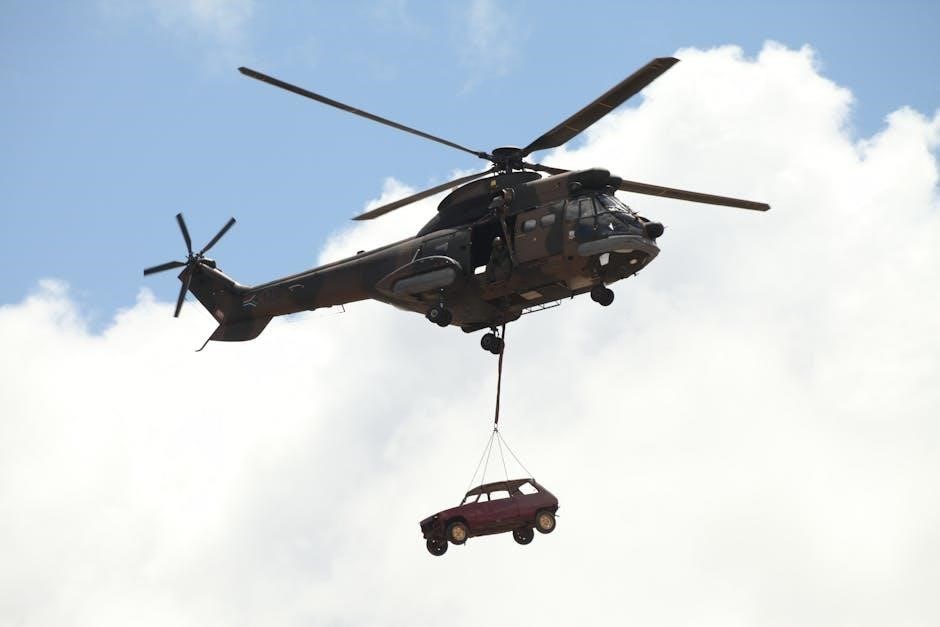
Aeronautical Decision-Making (ADM)
Aeronautical Decision-Making (ADM) involves systematic risk management, situational awareness, and crew coordination to ensure safe rotorcraft operations, integrating all factors affecting flight safety and efficiency effectively.
8.1 Risk Management and Mitigation
Risk management is a critical component of Aeronautical Decision-Making (ADM), enabling pilots to identify and mitigate potential hazards systematically. This process involves assessing the likelihood and impact of risks, such as weather conditions, mechanical failures, or human error. Effective mitigation strategies include adhering to safety protocols, conducting thorough pre-flight checks, and maintaining situational awareness. Crew Resource Management (CRM) plays a vital role in enhancing decision-making by fostering clear communication and collaboration among team members. Proactive risk management ensures safer rotorcraft operations by addressing potential issues before they escalate, thereby reducing the probability of accidents and improving overall flight safety.
8.2 Crew Resource Management (CRM)
Crew Resource Management (CRM) is a set of principles and practices designed to enhance flight safety by improving communication, decision-making, and teamwork. It emphasizes effective use of all available resources, including personnel, equipment, and information. CRM training focuses on developing situational awareness, leadership, and stress management skills. By fostering a culture of open communication and mutual respect, CRM reduces errors and enhances collaboration among pilots and other crew members. Regular CRM training is essential for rotorcraft operations, ensuring that teams can respond effectively to challenges and maintain safe, efficient flight operations under various conditions, as outlined in the Rotorcraft Flying Handbook.
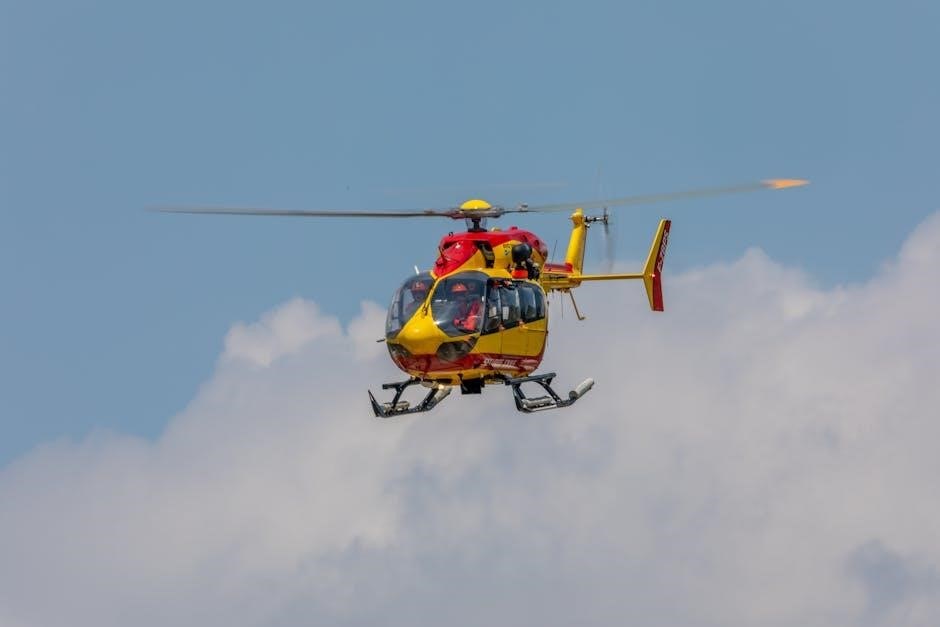
Legal and Regulatory Requirements
Compliance with certification standards, such as CAT A and B, ensures rotorcraft operations meet safety and performance regulations, adhering to type ratings and operational guidelines.
9.1 Certification Standards (CAT A, CAT B)
CAT A and CAT B are certification standards ensuring rotorcraft meet safety and performance requirements. These standards, set by aviation authorities, outline design, testing, and operational criteria for rotorcraft, distinguishing them from performance classes, which focus on operational conditions. Compliance is crucial for manufacturers and operators to ensure rotorcraft meet safety and performance benchmarks. These standards are separate from performance classes, which define operational limits like takeoff and landing conditions. Understanding these distinctions is vital for regulatory compliance and safe rotorcraft operations.
9.2 Type Ratings and Operating Regulations
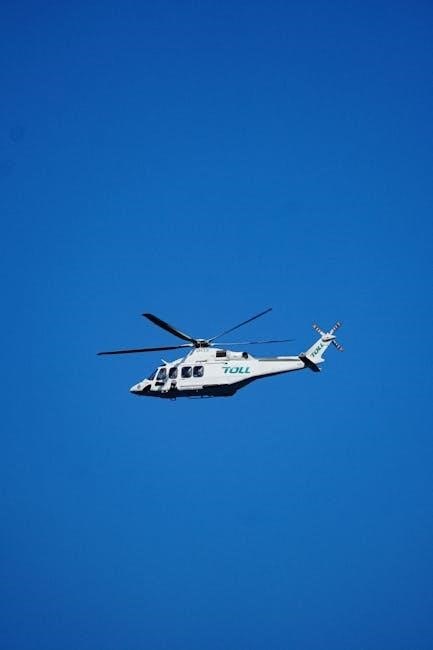
Type ratings are certifications required for pilots to operate specific rotorcraft models, ensuring they understand the aircraft’s unique characteristics and systems. These ratings are issued by aviation authorities and are distinct from general pilot licenses. Operating regulations outline the rules for rotorcraft usage, including flight hours, maintenance requirements, and safety protocols. Compliance with these regulations ensures safe and legal flight operations. Type ratings and operating regulations are critical for maintaining aviation safety standards and are regularly updated by regulatory bodies to reflect industry advancements and safety improvements. Pilots must adhere to these guidelines to operate rotorcraft legally and safely.
